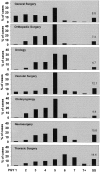Comparison of surgical outcomes between teaching and nonteaching hospitals in the Department of Veterans Affairs
- PMID: 11524590
- PMCID: PMC1422028
- DOI: 10.1097/00000658-200109000-00011
Comparison of surgical outcomes between teaching and nonteaching hospitals in the Department of Veterans Affairs
Abstract
Objective: To determine whether the investment in postgraduate education and training places patients at risk for worse outcomes and higher costs than if medical and surgical care was delivered in nonteaching settings.
Summary background data: The Veterans Health Administration (VA) plays a major role in the training of medical students, residents, and fellows.
Methods: The database of the VA National Surgical Quality Improvement Program was analyzed for all major noncardiac operations performed during fiscal years 1997, 1998, and 1999. Teaching status of a hospital was determined on the basis of a background and structure questionnaire that was independently verified by a research fellow. Stepwise logistic regression was used to construct separate models predictive of 30-day mortality and morbidity for each of seven surgical specialties and eight operations. Based on these models, a severity index for each patient was calculated. Hierarchical logistic regression models were then created to examine the relationship between teaching versus nonteaching hospitals and 30-day postoperative mortality and morbidity, after adjusting for patient severity.
Results: Teaching hospitals performed 81% of the total surgical workload and 90% of the major surgery workload. In most specialties in teaching hospitals, the residents were the primary surgeons in more than 90% of the operations. Compared with nonteaching hospitals, the patient populations in teaching hospitals had a higher prevalence of risk factors, underwent more complex operations, and had longer operation times. Risk-adjusted mortality rates were not different between the teaching and nonteaching hospitals in the specialties and operations studied. The unadjusted complication rate was higher in teaching hospitals in six of seven specialties and four of eight operations. Risk adjustment did not eliminate completely these differences, probably reflecting the relatively poor predictive validity of some of the risk adjustment models for morbidity. Length of stay after major operations was not consistently different between teaching and nonteaching hospitals.
Conclusion: Compared with nonteaching hospitals, teaching hospitals in the VA perform the majority of complex and high-risk major procedures, with comparable risk-adjusted 30-day mortality rates. Risk-adjusted 30-day morbidity rates in teaching hospitals are higher in some specialties and operations than in nonteaching hospitals. Although this may reflect the weak predictive validity of some of the risk adjustment models for morbidity, it may also represent suboptimal processes and structures of care that are unique to teaching hospitals. Despite good quality of care in teaching hospitals, as evidenced by the 30-day mortality data, efforts should be made to examine further the structures and processes of surgical care prevailing in these hospitals.
Figures
References
-
- Blumenthal D, Meyer GS. The future of the academic medical center under health care reform. N Engl J Med 1993; 329: 1812–1814. - PubMed
-
- Iglehart JK. Rapid changes for academic medical centers. N Engl J Med 1994; 331: 1391–1395. - PubMed
-
- Epstein AM. US teaching hospitals in the evolving health care system. JAMA 1995; 273: 1203–1207. - PubMed
-
- Iglehart JK. Rapid changes for academic medical centers, II. N Engl J Med 1994; 332: 407–411. - PubMed
-
- Kassirer JP. Academic medical centers under siege. N Engl J Med 1994; 331: 1370–1371. - PubMed
Publication types
MeSH terms
LinkOut - more resources
Full Text Sources
Medical


